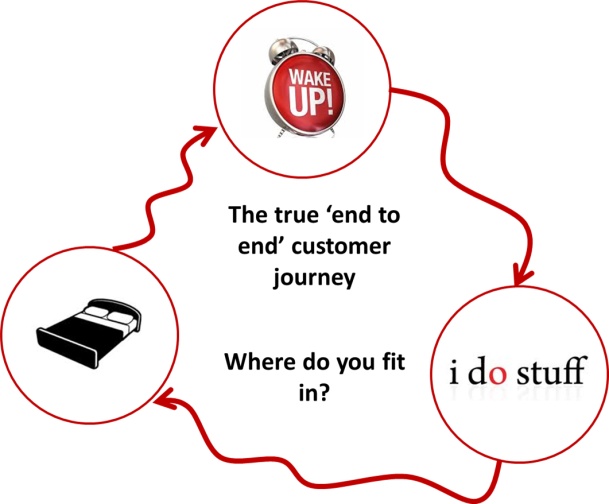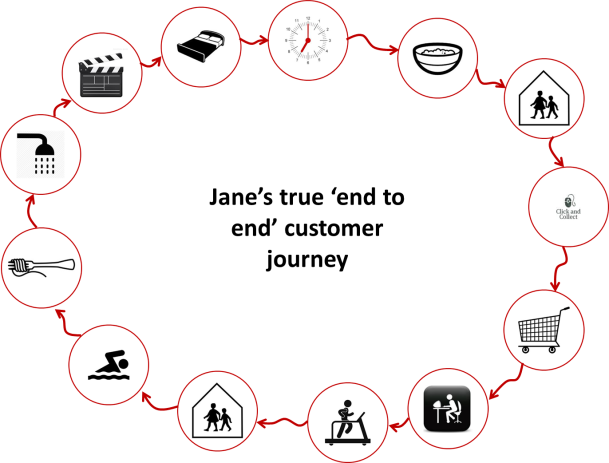
Have you heard the term ‘customer journey’? Silly question eh? It is becoming increasingly difficult to find anyone in business who has not heard the term. Hearing it and understanding it do not necessarily come hand in hand though. Whilst many hear ‘customer journey’ banded about as a term, there is still a very long way to go before the majority (rather than the minority) of organisations understand how to ‘map’ one, or ‘design’ one, or even know how to ‘improve’ one.
One thing that I must get straight right from the off is that every organisation that exists to serve customers already has a customer journey. This might seem like a strange thing to say, but whether you like it or not, and whether it is any good or not, you are already delivering a journey to your customers. My good friend and colleague Jerry Angrave advised a client of this fact recently – they were surprised to have never of thought of it themselves.
What can get confusing to businesses is that there is no right or wrong way to ‘map’ a customer journey. Simply conducting a Google search for the term will return a variety of images – here is a small selection:

None of these are right – none of them are wrong – they all served a purpose for the organisation that created them. What your customer journey map looks like is not important – and that is also not the subject of this blog post. Why you are creating a visualisation of the journey that your customers experience is vitally important. What your journey comprises is also critical – and that is the true focus of this blog post.
An increasing number of organisations are busily documenting their customer journey or customer journeys. More advanced businesses are even designing new customer journeys using more sophisticated techniques and practices. Some focus on the TRANSACTIONAL customer journey – the journey that starts when a customer chooses to interact with you, and ends when they have completed their transaction. Others are more concerned with the RELATIONAL journey – the journey that comprises repeat transactions over time. What many fail to do though is consider what I call the TRUE ‘end to end’ customer journey.
Whilst it is important to understand what the journey looks like that your organisation is responsible for delivering, it is equally important to understand where that journey fits in to the context of your customers lives. If you think about it, every day for us as a consumer is a mini journey in itself. It starts when we wake up, and ends when we return to our beds. What we do in between is the ‘stuff’ that makes up the rest of our journey. The true ‘end to end’ customer journey starts and ends in bed (hopefully!) every single day. Despite this fact, not many of us map the customer journey with this in mind.
Understanding the true customer journey can help bring to life why customers do what they do, and help explain why an organisations existing customer journey may or may not work. Let us have a look at a simple example. Jane is a mum of three young children – all are at primary school. She is normally woken up at 07:00 – at this point, her daily journey commences. She showers, and then comes downstairs to make the kids breakfast. All of her kids like porridge – the new trend for easy sachets has made it quicker and easier for her. Once breakfast is over, the kids are ready for school.
The next stage of her journey is to get the kids to school. Living only a mile away, they usually walk. Jane ordered a new dress online the previous day, and knows that if she walks past her local garage, she can collect the dress from a ‘click and collect point’. Once the kids have been dropped off, it is back home to do some more ‘stuff’. Jane needs to do some food shopping – she chooses to go to her local ‘superstore’ as it is easy to get to and has free parking. Once done, it is back home to put the shopping away. Having completed some work she conducts from home part-time, she decides she has enough time to visit the gym. Gym complete, she has time for a quick lunch at home, before picking up the kids from school.
The next stage of the journey sees Jane dropping off her daughters for their weekly theatre school fix, whilst taking her son for his swimming lesson. After a pasta dinner at home, it is bath and shower time for the kids, before bedtime. Once the kids have gone to sleep, Jane decides to watch a movie via her internet TV. Her journey for this particular day is almost over. Having caught up with Facebook, she turns off her light and goes to sleep.

If you consider this ‘true’ customer journey, you will notice that my fictional Jane has interacted with a number of different brands and organisations during the day. Each one of these interactions has a potential link to another, and understanding what she does, can potentially help to inform each individual journey. Jane will be typical of a certain type of customer of each organisation she transacts with – her ‘persona’ is an imperative insight into how to design a customer journey. Unless you truly put yourself into your customers shoes, it is difficult to understand if the journey that you have as a legacy, or the new journey that you are designing will meet her needs.
So ask yourself these questions:
- Do we know what our customer journey looks like?
- Do we understand the transactional journey or the relational journey or both?
- Do we understand where our journey fits in to our customers true ‘end to end’ journey
- Do we understand who our customers are?
- Have we created customer personas?
Understanding a day in the life of a typical customer is becoming more and more important in a world where businesses aspire to deliver customer journeys that increasingly meet customer expectation. By mapping your journey in context with the ‘other stuff’ a customer does during the day will help you to determine if changes or improvement needs to be made. Does your journey do what your customer needs you to do when she needs you to do it – and does it make her feel good about it. How she feels will be affected by everything else she may be doing or have to do during her true daily ‘end to end’ journey.



